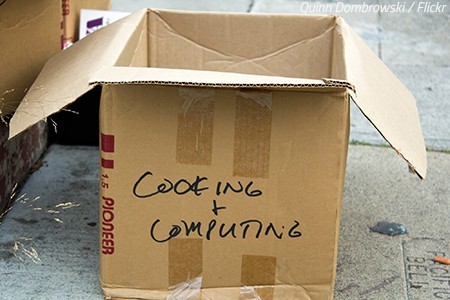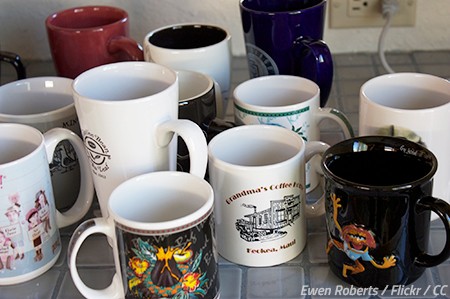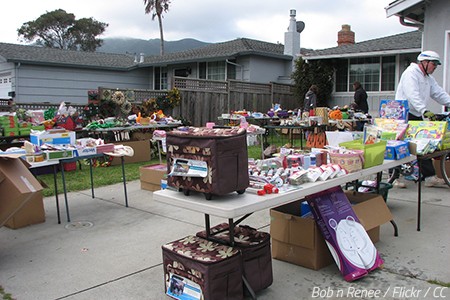Everybody is entitled to their own opinion, but if you ask 10 random people to name the most disorganized process in life, you can rest assured that at least a few of the answers will be about the transitional period of moving to another home.
Despite the bad reputation of moving, disorganization, chaos, and stress are the three words you don’t have to hear while you are getting ready to move out of your current home. And without a doubt, packing for a move is the most chaotic task you’ll have to deal with during your preparation.
One of the ways to help you introduce structure and order into packing is to devise a smart and foolproof labeling system for your already packed cardboard boxes.
After all, if you’re already thinking about the best way to label moving boxes, then this means that one of the most difficult, laborious, and time-consuming tasks (yes, packing!) is being tackled in a timely manner and should have a successful end for you.
How can you make sure that the boxes you pack get delivered to the correct new-home rooms? How to label your moving boxes so that you save valuable post-move time by NOT opening random containers in search of your possessions?
Read on to learn how to label moving boxes properly.
Understand why labeling boxes matters
Don’t make the rookie mistake of thinking that labeling your moving boxes is a waste of time. Even if you happen to be blessed with an excellent memory, using a moving box labeling system is a must-do task for several good reasons:
Who knows what non-labeled moving boxes hide inside…
Moving house is a rather stressful period so even people with an infallible memory can have trouble remembering what is where after they are done with packing;
Cardboard boxes look identical so it can be almost impossible to keep track of what’s inside them if you choose not to label them like you should;
When unlabeled, cardboard boxes cannot be taken to their respective destination rooms. Instead, they will get delivered to the new home and stacked up in one big room which in turn will make the sorting process a living nightmare.
You will lose many hours trying to figure out which box goes where and opening random boxes won’t help either. As a result, you’re likely to get genuinely frustrated within the first hour or so after your non-labeled containers have been delivered to the new place;
Some of your fragile items may get broken during the haul due to the lack of warning signs and handling instructions such as FRAGILE, HANDLE WITH CARE, and THIS SIDE UP.
Where to Find Free Moving Boxes
Get the timing right when labeling boxes
When labeling boxes for moving, timing plays an important role in boosting the overall efficiency.
You should always mark down the contents, destination room, and any special handling instructions on a container as soon as you are done packing it. This is the correct way of doing it simply because if you postpone the labeling job until you’ve packed a few boxes (or all of them!), then it’s possible that you forget what’s inside them. And that, of course, can lead to additional waste of time after the move.
And of course, you cannot label a box before packing it up because you don’t know yet what exactly you’ll pack inside it. For best results, you should follow the logical packing sequence of PACK, SEAL, and LABEL each moving box.
Prepare your box labeling tools
Good and timely moving tips can make your entire relocation as easy and fast as it can possibly be. Our advice on how to label packing boxes kicks off with a few words about what labeling tools you will need to create a good labeling system for your moving containers.
High-quality markers
The usage of different colors when labeling your boxes for moving is highly recommended.
The very first thing you must have to label your moving boxes properly is a set of permanent markers to mark down your containers. Now, while ordinary marker pens will most likely be OK for the labeling job ahead of you, you are advised to go a step further and keep these basic requirements in mind:
Good quality. For obvious reasons, avoid the temptation to purchase the cheapest markers you can possibly find. Instead, go for a set of markers from a quality brand which you are familiar with and can trust. This way, you can use the writing tools for other purposes long after the house move is over.
Colors. If you wish to take advantage of the highly efficient color-coded labeling system, then purchase a set of markers with at least 5 different colors. Read on to learn all about this practical color-coding labeling strategy.
Permanent and waterproof. You never know what the weather will be like on your moving day, so it’s always a good idea to be prepared for the eventuality of rain. And if you don’t use waterproof marker pens, your inscriptions on the sides of the boxes might smudge and become illegible.
Labels
Keep in mind that ready-to-use downloadable and printable moving box labels are available on the Internet for free.
If you really want, you can purchase labels from your local moving company as well. Those labels have the names of the different rooms already printed on them, so you only need to fill out the contents of each container.
On the other hand, if you have enough time and expertise, you can even design your own moving box labels to add some fun to the relocation process.
Colored tape
Of course, you’ll have plenty of clear packing tape lying around but if you really want to raise your labeling system to another level, you should use colored tape to enhance the box identification when you find yourself in your new home.
The Best Packing Tips for Moving
Use colors to label moving boxes
Using different colors to label your boxes will help you identify them much faster after the move.
It’s good to know that the best way to label boxes when moving is through the so-called color-coding system. The concept is really simple yet very effective – you just choose one color for one destination room and stick with it until the very end. In fact, it can’t get any simpler than that.
For example, you choose the color blue to mean BEDROOM, in which case you take out your blue marker and mark with it all the packed boxes that should end up in your bedroom. Of course, in addition to writing BEDROOM on them, you should specify the exact contents inside each container as well.
Also, you are encouraged to use colored tape of the corresponding color to simplify the identification process as best as you can. Once you’ve labeled and marked all bedroom-bound moving boxes in blue, you should choose another color for another destination area (for example, green for your KITCHEN) and repeat the labeling steps.
However, be cautious because the color-coded labeling system can be a bit tricky. The thing is that you know what each color means, but do your movers know it as well? They might have trouble delivering the right boxes into the right rooms unless they also know what each individual color means.
So, place colored pieces of paper on the doors of your new home that match the color-coded cardboard boxes.
Use numbers to label moving boxes
Another great way to label boxes for shipping is to use numbers instead of color codes. The great advantage of using this numbered labeling system is that you won’t need to mark down the contents of each box on 3 of its sides. This, of course, will save you plenty of time.
The main idea of using numbers to mark your packing boxes is to designate a unique number for each container (for instance, #1). Then, you create a master inventory list where the contents of each box number will be written down in detail.
In our case, Box #1 may contain your coffee maker and toaster, so you mark them down in your checklist against number 1, while you write KITCHEN and #1 on three sides of the box itself. This way, your movers will see that they should deliver the box in question into the new-home kitchen, while your inventory sheet will tell you more about what that box contains.
The trickiest part here is that you must make sure you don’t lose that master inventory checklist. Photocopy it at least twice and keep the copies in separate places. To ensure there won’t be any headaches, you are also advised to e-mail the checklist to yourself or to a friend as an extra backup.
What to Pack When Moving: Packing Checklist
Label your boxes like a professional packer
There are no strict rules on how exactly you will label your moving boxes as it is a uniquely individual process that comes down to personal preferences. And yet, you are encouraged to follow a few guidelines which have been proven to work great and which should help you eliminate the chances of making unpleasant packing mistakes.
For best results, follow these tips for labeling your moving boxes to complete the packing project in style:
Labeling your moving boxes for moving is not overly complicated. It’s just something you need to do to save time and avoid post-move confusion.
Pick the box labeling method that you feel most comfortable with and stick with it until you’ve labeled all your moving boxes. The worst you can do while labeling boxes when moving house is to decide to switch from one labeling method to the other in the middle of the packing process.
Write the following information on each box (unless you’re using numbers): destination room, contents, and handling instructions. If you just finished packing a box full of fragile and breakable items, you must mark that fact down on the outside of the box so that whoever’s handling it can be more careful. Whenever needed, write FRAGILE or HANDLE WITH CARE with big black or red letters to attract the carrier’s attention.
Label the top and two sides of each cardboard box. You want to make sure that your writing will be visible on at least one side even when the boxes are neatly stacked one on top of the other. After all, you can’t afford to waste valuable time moving around and looking at each and every container until you get lucky enough to spot the one you need at that very moment.
Attach moving labels to your boxes by using clear packing tape over them so that they don’t fall off, or get torn or wet during transportation. You could choose to use glue to make the colored or non-colored labels stay where they are supposed to, but that is usually slower than taping the labels over with quality tape. Besides, using glue can make things unnecessarily messy during the haul.
Be extra careful when labeling second-hand boxes. If you have secured used cardboard boxes in great condition, some of the containers may already have inscriptions and markings on them. To avoid confusion, tape your labels directly above the old ones to mask them. If that is not really possible, then take pieces of colored paper and just glue them over the old labels or stickers.
Consult this FMCSA Moving Checklist to make sure you are 100% ready to move.
It’s not a big secret that packing up an entire home can prove to be a truly overwhelming job. In fact, it’s one of those pre-move tasks where extra non-professional or professional help is strongly advised.
And if packing up all your earthly possessions proves to be too much for you, why don’t you contact reputable full-service moving companies and ask them to quote you a price that includes the add-on service of professional packing?
The efficiency, safety, insurance, and peace of mind you get when letting professional packers do what they do best should be worth every single dollar of your investment.
Packing Checklist: Packing Timeline For Moving
The post How to Label Moving Boxes: Read and Write With Care appeared first on The Moving Blog.







